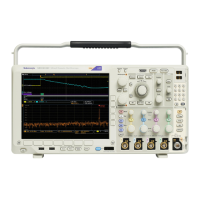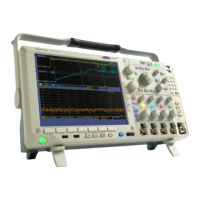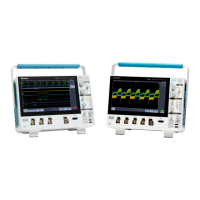Commands Listed in Alphabetical Order
NOTE. External
filestructureisasfollows:
E: is the USB memory device plugged into the first USB port on the front of the
oscilloscope
.
F: is the USB memory device plugged into the second USB port on the front of the
oscillosco
pe. (Not available for MDO3000.)
G: and H: are the USB memory device plugged into the USB ports on the rear o f
the oscillo
scope. (Not available for MDO3000 models.)
I: – Z are the network storage.
Group
Save and Recall
Syntax
SAVe:SETUp {<file p ath>|<NR1>}
Related Commands
*RCL, RECAll:SETUp,
*SAV
Arguments
<file p ath> is the target location for storing the setup file. <file path> is a
quoted string that defines the file name and path. Input the file path using the
form <drive>:<dir>/<filename>. <extension> and one or <dir>s are optional.
If you do not specify them, the oscilloscope will store the file in the current
working directory. <filename> stands for a filename. (Use of wildcard characters
in filenames is not supported.) Filename extensions are not required but arehighly
recommended. For setups, use the extension ".SET".
<NR1> specifies a location for saving the current front-panel setup. The
front-panel setup value ranges from 1 to 10. Using an out-of-range value causes
an execution error. Any settings that have been stored previously at this location
will be overwritten.
Examples
SAVE:SETUP 5 saves the current oscilloscope setup in memory location 5.
SAVE:SETUP "TEK00000.S ET" saves the current oscilloscope setup in the file
TEK00000.SET in the current working directory.
SAVe:WAVEform (No Query Form)
This command saves the specified waveform to the specified destination
reference memory slot, or saves the specified waveform(s) to the specified
destination file. The same function can be accomplished from the front panel
2-598 MDO4000/B/C, MSO/DPO4000B and MDO3000 Series Oscilloscopes Programmer Manual

